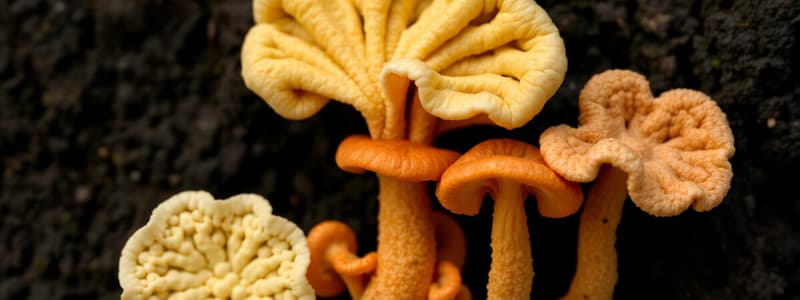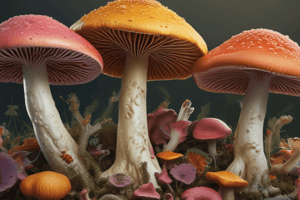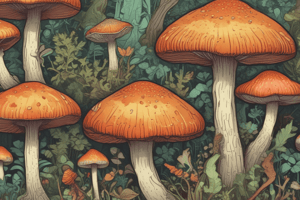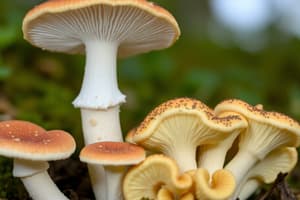Podcast
Questions and Answers
Which mode of transmission involves skin trauma or mucous membrane exposure?
Which mode of transmission involves skin trauma or mucous membrane exposure?
- Ingestion
- Absorption
- Inhalation
- Inoculation (correct)
What is the first step in the fungal culture process?
What is the first step in the fungal culture process?
- Direct examination of specimen
- Evaluation of fungal growth
- Specimen collection and transportation (correct)
- Selection and inoculation of media
Which of the following is NOT part of the fungal culture process?
Which of the following is NOT part of the fungal culture process?
- Evaluation of fungal growth
- Serological testing
- Virus isolation (correct)
- Antifungal susceptibility testing
What characterizes the production of both sexual and asexual spores?
What characterizes the production of both sexual and asexual spores?
Which process directly follows the collection and transportation of a specimen?
Which process directly follows the collection and transportation of a specimen?
What is the appropriate pretreatment method for respiratory specimens?
What is the appropriate pretreatment method for respiratory specimens?
Which pretreatment method is specifically used for nails?
Which pretreatment method is specifically used for nails?
Which of the following is NOT a method for pretreatment of medical devices?
Which of the following is NOT a method for pretreatment of medical devices?
Which specimen requires mincing or grinding as a pretreatment step?
Which specimen requires mincing or grinding as a pretreatment step?
What pretreatment process is used for body fluids?
What pretreatment process is used for body fluids?
What type of hyphae has numerous cross-walls?
What type of hyphae has numerous cross-walls?
Which type of fungal growth is typically smooth, creamy, pasty, or mucoid?
Which type of fungal growth is typically smooth, creamy, pasty, or mucoid?
What is the purpose of vegetative hyphae?
What is the purpose of vegetative hyphae?
Which of the following describes coenocytic hyphae?
Which of the following describes coenocytic hyphae?
Which pigment characteristics describe hyaline mycelium?
Which pigment characteristics describe hyaline mycelium?
What is the visual characteristic of dimorphic fungi?
What is the visual characteristic of dimorphic fungi?
What does a racquet hyphae resemble?
What does a racquet hyphae resemble?
Which type of hyphae is responsible for holding the conidia?
Which type of hyphae is responsible for holding the conidia?
Which site is NOT a recognized portal of entry for fungal infections?
Which site is NOT a recognized portal of entry for fungal infections?
What is the main reason for keeping a specimen moist during transport?
What is the main reason for keeping a specimen moist during transport?
What should be done immediately after specimen collection?
What should be done immediately after specimen collection?
Which technique is essential when collecting specimens from a site with normal flora?
Which technique is essential when collecting specimens from a site with normal flora?
What is the best specimen type for identifying the etiologic agent of a fungal infection?
What is the best specimen type for identifying the etiologic agent of a fungal infection?
What is the maximum time allowed for transporting blood specimens at room temperature?
What is the maximum time allowed for transporting blood specimens at room temperature?
Which of the following specimen types requires scraping for collection?
Which of the following specimen types requires scraping for collection?
What is the preferred method of collecting cerebrospinal fluid (CSF) before inoculation?
What is the preferred method of collecting cerebrospinal fluid (CSF) before inoculation?
For respiratory specimens, what is recommended if a patient cannot produce a sputum sample?
For respiratory specimens, what is recommended if a patient cannot produce a sputum sample?
What is the maximum time allowed for skin specimen transport at room temperature?
What is the maximum time allowed for skin specimen transport at room temperature?
Which specimen collection requires the deepest scraping using KOH preparation?
Which specimen collection requires the deepest scraping using KOH preparation?
How soon should a urinary specimen be collected after the bladder is emptied?
How soon should a urinary specimen be collected after the bladder is emptied?
What should be done to skin before scraping for specimen collection?
What should be done to skin before scraping for specimen collection?
What type of specimen collection is advised for prostatic fluid?
What type of specimen collection is advised for prostatic fluid?
Which specimen type should never be refrigerated?
Which specimen type should never be refrigerated?
What is the proper way to collect external ear specimens?
What is the proper way to collect external ear specimens?
What is the maximum time allowed for transporting vitreous fluid?
What is the maximum time allowed for transporting vitreous fluid?
When collecting tissue biopsies, what is essential to keep them moist?
When collecting tissue biopsies, what is essential to keep them moist?
Flashcards are hidden until you start studying
Study Notes
Fungi Overview
- Fungi can be categorized into two main forms: yeasts and molds.
- Yeasts have a smooth, creamy, pasty appearance and reproduce by budding, resulting in blastoconidia.
- Molds exhibit filamentous growth due to mycelia formation.
Hyphae Types
- Septate Hyphae: Contains numerous cross-walls, dividing hyphae into compartments.
- Coenocytic (Aseptate) Hyphae: Features few or no cross-walls.
Pigmentation in Hyphae
- Hyaline Hyphae: Non-pigmented, clear, and transparent; colorless unless stained, appearing blue upon staining.
- Dematiaceous Hyphae: Pigmented with black or brown coloration.
Mycelium
- Mycelium is a mass of branching, intertwined hyphae important for nutrient absorption.
- Aerial hyphae are the filamentous structures that hold conidia, while vegetative mycelium absorbs nutrients from culture media.
Vegetative Hyphae Shapes
- Antler Hyphae: Resemble antlers.
- Nodular Hyphae: Knot-like formations.
- Racquet Hyphae: Shaped like racquets.
Modes of Transmission
- Fungi can reproduce via:
- Asexual spores
- Sexual and asexual spores
- Transmission can occur through:
- Inhalation
- Inoculation via skin trauma or mucous membranes
- Ingestion
Fungal Culture Process
- Important steps include specimen collection, direct examination, media selection, evaluation of fungal growth, serological testing, and antifungal susceptibility testing.
Specimen Collection and Transport
- Accurate specimen collection is critical for diagnosing fungal infections:
- Common sites include skin, hair, nails, respiratory tract, gastrointestinal tract, and urinary tract.
- Sterile techniques are essential to avoid contamination.
- Specimens should be kept moist and transported promptly.
Direct Examination Techniques
- Direct examination can involve various collection methods, like scraping and using sterile tools for samples.
- Hair samples should remain intact, while nails can be collected as scraping or cuttings for better yield.
Pre-treatment of Clinical Specimens
- Pre-treatment methods vary based on specimen type, e.g.:
- Blood undergoes lysis and centrifugation.
- Body fluids are filtered and centrifuged.
- Respiratory specimens may require liquefaction with mucolytic agents.
Specimen Handling Guidelines
- Ensure proper labeling and immediate processing of specimens.
- Specific handling protocols differ for various specimen types, emphasizing timely transport and temperature conditions.
Collected Specimen Types
- Common specimen types include:
- Blood and sterile fluids
- Bone marrow
- Catheter samples
- Cerebrospinal fluid (CSF)
- Skin, hair, nails, and respiratory specimens
- Tissue biopsies and vaginal swabs.
Studying That Suits You
Use AI to generate personalized quizzes and flashcards to suit your learning preferences.




